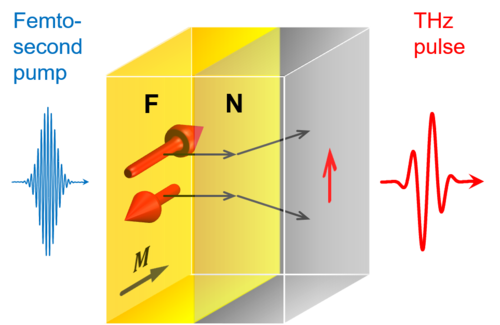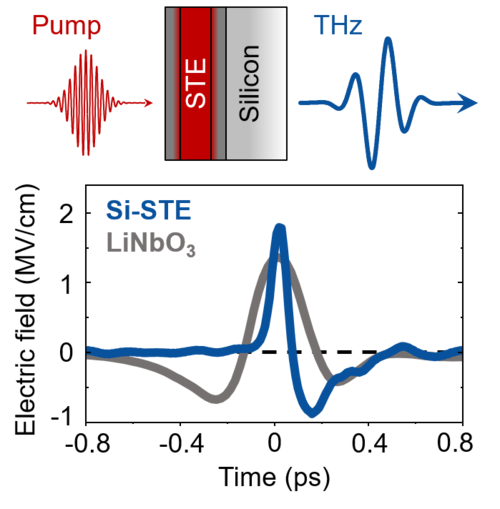Editors' suggestions of Phys. Rev. journals highlight TRR 227 research on THz spintronics
Figure 1: Spintronic terahertz emitter (STE)
Figure 2: Ultrafast demagnetization (UDM) and THz spin transport (TST)
Figure 3: Si-based spintronic THz emitter (Si-STE) with optimized photonic and heat environment
News from Mar 14, 2023
Understanding and improving spintronic terahertz-wave emission:
Spintronic terahertz (THz) emitters (STEs) are a novel class of broadband, low-cost and efficient THz sources (see Fig. 1). They exhibit interesting opportunities for applications in the fields of THz physics and THz photonics where THz electromagnetic pulses are used for material characterization, imaging and spectroscopy. Consequently, STEs are meanwhile commercially available from the Berlin-based startup TeraSpinTec GmbH.
To trigger the emission of ultrashort THz electromagnetic pulses, an STE is driven by femtosecond laser pulses (see Fig. 1 above). As a consequence, THz spin transport from a ferromagnetic thin film F with magnetization M is driven into an adjacent layer N, which consists of a heavy metal such as platinum. In N, the spin flow is converted into an in-plane charge current that acts as a source of an ultrashort THz electromagnetic pulse.
To further improve the efficiency of STEs, research teams of the Collaborative Research Center 227 at Freie Universität Berlin and Martin-Luther-Universität Halle followed a two-fold strategy. First, they revealed the origin of the spin transport. Second, they applied various photonic and thermal measures to enhance the STE performance.
The relevance of both works is also highlighted by the fact that they were selected as “Editors' suggestion” of the journals in which they are published.
In the first work, Reza Rouzegar and colleagues address the force that drives the ultrafast spin transport. Remarkably, they observe that laser-induced ultrafast demagnetization (UDM) of a metallic ferromagnet F (Fig. 2a) has the same time evolution as THz spin transport (TST) from F into an adjacent normal metal N (Fig. 2b). They conclude that UDM in a single F layer and TST in a F|N stack are driven by the same force: a generalized spin voltage (Fig. 2c), which is an excess magnetization of F. One can now apply the vast knowledge of UDM to TST to significantly increase spin-current amplitudes for ultrafast spintronic applications.
In the second work, Reza Rouzegar and Alex Chekhov present a Si-based spintronic THz emitter (Si-STE) with optimized photonic and heat environment (see Fig. 3). The Si-STE delivers THz pulses with a peak electric field beyond 1.5 MV/cm, a fluence of the order of 1 mJ/cm2 and a spectrum covering the range 0.1-11 THz (see figure above). Remarkably, the field and fluence values are comparable to those obtained from a state-of-art LiNbO3 source based on tilted-pulse-front optical rectification. In additional, Si-STEs offer many attractive features such as easy alignment and rotation of the THz polarization plane without any power loss. Si-STEs, thus, opes up a highly promising pathway to nonlinear THz spectroscopy.
Original publications:
- R. Rouzegar, L. Brandt, L. Nádvorník, D. A. Reiss, A. L. Chekhov, O. Gueckstock, C. In, M. Wolf, T. S. Seifert, P. W. Brouwer, G. Woltersdorf, and T. Kampfrath
Laser-induced terahertz spin transport in magnetic nanostructures arises from the same force as ultrafast demagnetization
Phys. Rev. B 106, 144427 (2022)
- R. Rouzegar, A. L. Chekhov, Y. Behovits, B. R. Serrano, M. A. Syskaki, C. H. Lambert, D. Engel, U. Martens, M. Münzenberg, M. Wolf, G. Jakob, M. Kläui, T. S. Seifert, and T. Kampfrath
Broadband spintronic terahertz source with peak electric fields exceeding 1.5 MV/cm
Phys. Rev. Applied 19, 034018 (2023)


